|
Most equity indexes retreated last week and the U.S. dollar soared as investors waited for central bank policy decisions and monitored the trade rhetoric between China and the U.S. among others. The week began at the conclusion of the Group of Seven meeting. U.S. president Trump refused to sign the document. Then he flew to the summit with North Korea. An agreement was signed but contained few specifics.
The week was dominated by central bank decisions —
The first central bank to meet (Federal Reserve) raised interest rates; the second central bank (European Central Bank) promised to end its quantitative easing program this year and the third central bank (Bank of Japan) did nothing. Below is a brief description of their individual policy decisions in the order in which they met.
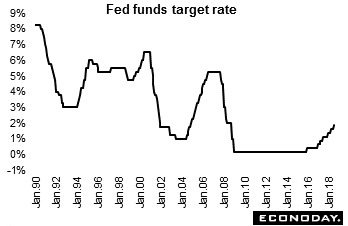 As widely expected, the FOMC increased its fed funds target range by 25 basis points to a range of 1.75 percent to 2.00 percent in a unanimous vote. The committee's forecasts indicate that there will be two more rate increases in 2018. Regarding the press conferences, beginning in 2019, they will be held after every FOMC meeting. They are currently held four times a year. Both the Bank of Japan and the European Central Bank hold press conferences after each of their respective monetary policy meetings. As widely expected, the FOMC increased its fed funds target range by 25 basis points to a range of 1.75 percent to 2.00 percent in a unanimous vote. The committee's forecasts indicate that there will be two more rate increases in 2018. Regarding the press conferences, beginning in 2019, they will be held after every FOMC meeting. They are currently held four times a year. Both the Bank of Japan and the European Central Bank hold press conferences after each of their respective monetary policy meetings.
Chair Jerome Powell described the U.S. economy as being in ‘great shape'. He stressed strong employment growth over the last couple of years as a case in point. In reaction to this, Powell said the Fed, after years of accommodation, is now normalizing policy in a gradual way in an effort to head off the risk of wage-driven inflation. Powell warned that inflation, thanks to high oil prices, may run over the Fed’s 2 percent symmetric target during the summer, but only briefly. On the risk of wage inflation, he cited reports of labor shortages but noted that there has yet, in what he concedes is a mystery, to be much reaction in wages.
On Washington policies, he said lower tax rates and fiscal stimulus will likely have a "significant" positive impact on demand. On tariffs, he acknowledged reports that they may be holding down business investment and hiring but he emphasized that such effects have yet to appear in the economic numbers.
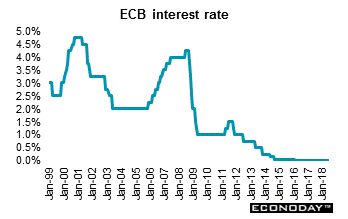 As universally expected, the European Central Bank announced no changes to any of its key interest rates. The benchmark refi rate stays at zero percent, the deposit rate at minus 0.40 percent and the marginal lending facility rate at 0.25 percent. As universally expected, the European Central Bank announced no changes to any of its key interest rates. The benchmark refi rate stays at zero percent, the deposit rate at minus 0.40 percent and the marginal lending facility rate at 0.25 percent.
However the ECB announced some important changes to its quantitative easing program. Specifically, net asset purchases will continue at €30 billion a month through September as already planned. But, thereafter, will be tapered to €15 billion per month through December depending on economic data. This will mark the end of the program, implying that, as of that date, the ECB will no longer be injecting additional liquidity into the economy. Policy is not being tightened but it will not be loosened any further as the balance sheet is kept steady.
Regarding forward guidance, the ECB indicated that it expects interest rates to be held at current levels at least through the summer of 2019 or as long as is thought necessary. In addition, it will maintain its current policy of reinvesting the principal payments from maturing securities purchased under the asset purchase programs (APP) for an extended period of time after the end of the net asset purchases, and in any case for as long as necessary to maintain favorable liquidity conditions and an ample degree of monetary accommodation.
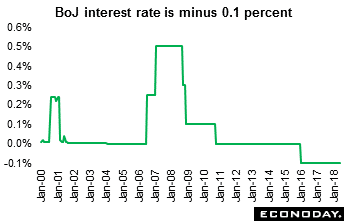 As widely anticipated, the Bank of Japan left its monetary policy unchanged. The BoJ's short-term policy rate for excess reserves remains at minus 0.1 percent while the target level for the long-term 10-year yield remains at around zero percent. The monetary policy board again voted 8 to1 in favor of this decision. As widely anticipated, the Bank of Japan left its monetary policy unchanged. The BoJ's short-term policy rate for excess reserves remains at minus 0.1 percent while the target level for the long-term 10-year yield remains at around zero percent. The monetary policy board again voted 8 to1 in favor of this decision.
The BoJ's policy framework involves adjusting the pace of their purchases of Japanese government bonds (JGBs) in order to keep the 10-year yield close to its target level. For now, the monetary policy board believes that purchasing these bonds at an annual rate of ¥80 trillion is consistent with meeting this target. The MPB reaffirmed their commitment to keep expanding the monetary base until the annual increase in the consumer price index (excluding fresh food) exceeds their inflation target of 2.0 percent and stays above this level "in a stable manner".
The BoJ’s assessment of the growth and inflation outlook was little changed from previous statements. Japan's economy is "expanding moderately" and is expected to continue this moderate expansion, boosted by ongoing support from both monetary and fiscal policy and solid external demand. Regarding inflation, the MPB noted that the annual change in the core CPI is currently in the range of 0.5 percent to 1.0 percent, compared with "around 1.0 percent" earlier in the year. However, the Bank remains confident this measure will trend higher towards their 2.0 percent inflation target, reflecting an improved output gap and stronger inflation expectations.
In his post meeting press conference, BoJ Governor Haruhiko Kuroda said that recent weakness in inflation was partly due to the strength of the domestic currency and productivity gains in the services sector. Nevertheless, he expressed confidence that momentum towards reaching the 2.0 percent inflation target remained intact, and dismissed suggestions that a comprehensive review of policy settings was required.
| |
|
2017 |
2018 |
% Change |
|
Index |
Dec 29 |
June 8 |
June 15 |
Week |
2018 |
| Asia/Pacific |
|
|
|
|
|
|
| Australia |
All Ordinaries |
6167.3 |
6156.8 |
6205.3 |
0.8% |
0.6% |
| Japan |
Nikkei 225 |
22764.9 |
22694.5 |
22851.8 |
0.7% |
0.4% |
|
Topix |
1817.56 |
1781.44 |
1789.0 |
0.4% |
-1.6% |
| Hong Kong |
Hang Seng |
29919.2 |
30958.2 |
30309.5 |
-2.1% |
1.3% |
| S. Korea |
Kospi |
2467.5 |
2451.6 |
2404.0 |
-1.9% |
-2.6% |
| Singapore |
STI |
3402.9 |
3436.4 |
3356.7 |
-2.3% |
-1.4% |
| China |
Shanghai Composite |
3307.2 |
3067.2 |
3021.9 |
-1.5% |
-8.6% |
|
|
|
|
|
|
|
| India |
Sensex 30 |
34056.8 |
35443.67 |
35622.1 |
0.5% |
4.6% |
| Indonesia |
Jakarta Composite |
6355.7 |
5993.6 |
5993.6 |
0.0% |
-5.7% |
| Malaysia |
KLCI |
1796.8 |
1778.3 |
1761.8 |
-0.9% |
-1.9% |
| Philippines |
PSEi |
8558.4 |
7740.7 |
7529.5 |
-2.7% |
-12.0% |
| Taiwan |
Taiex |
10642.9 |
11156.4 |
11087.5 |
-0.6% |
4.2% |
| Thailand |
SET |
1753.7 |
1722.0 |
1704.8 |
-1.0% |
-2.8% |
|
|
|
|
|
|
|
| Europe |
|
|
|
|
|
|
| UK |
FTSE 100 |
7687.8 |
7681.1 |
7633.9 |
-0.6% |
-0.7% |
| France |
CAC |
5312.6 |
5450.2 |
5501.9 |
0.9% |
3.6% |
| Germany |
XETRA DAX |
12917.6 |
12766.6 |
13010.6 |
1.9% |
0.7% |
| Italy |
FTSE MIB |
21853.3 |
21356.0 |
22190.5 |
3.9% |
1.5% |
| Spain |
IBEX 35 |
10043.9 |
9746.3 |
9851.0 |
1.1% |
-1.9% |
| Sweden |
OMX Stockholm 30 |
1576.9 |
1555.9 |
1570.4 |
0.9% |
-0.4% |
| Switzerland |
SMI |
9381.9 |
8512.1 |
8642.6 |
1.5% |
-7.9% |
|
|
|
|
|
|
|
| North America |
|
|
|
|
|
|
| United States |
Dow |
24719.2 |
25316.53 |
25090.5 |
-0.9% |
1.5% |
|
NASDAQ |
6903.4 |
7645.5 |
7746.4 |
1.3% |
12.2% |
|
S&P 500 |
2673.6 |
2779.0 |
2779.7 |
0.0% |
4.0% |
| Canada |
S&P/TSX Comp. |
16209.1 |
16202.7 |
16314.4 |
0.7% |
0.6% |
| Mexico |
Bolsa |
49354.4 |
45939.5 |
46938.8 |
2.2% |
-4.9% |
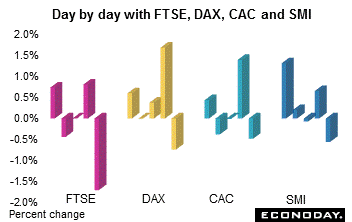 European equity indexes advanced on the week with the exception of the FTSE. The FTSE lost 0.6 percent on the week because of Friday’s tumble. Elsewhere, the CAC advanced 0.9 percent, the DAX added 1.9 percent and the SMI was 1.5 percent higher. A day after the European Central Bank announced plans to end its bond purchases, markets turned their attention to international trade. They tumbled on renewed concerns over a global trade war. European equity indexes advanced on the week with the exception of the FTSE. The FTSE lost 0.6 percent on the week because of Friday’s tumble. Elsewhere, the CAC advanced 0.9 percent, the DAX added 1.9 percent and the SMI was 1.5 percent higher. A day after the European Central Bank announced plans to end its bond purchases, markets turned their attention to international trade. They tumbled on renewed concerns over a global trade war.
Investors here were cautious during the week given the three key central bank meetings and a Brexit vote in the House of Commons. In addition, investors were unsure what to make of the results of the summit between U.S. President Donald Trump and North Korean leader Kim Jong Un. Although both leaders signed a joint statement pledging to work together, the agreement fell short on key details.
On Monday, European markets recorded modest gains despite trade concerns after U.S. President Trump backed out of signing onto a joint G-7 communiqué over the weekend. The Italian stock market surged after comments from its finance minister soothed investor concerns that the country would exit the euro area. Italian Economy Minister Giovanni Tria said that the new government has no plans to leave the euro and is seeking to boost growth through investment and structural reforms instead of deficit spending.
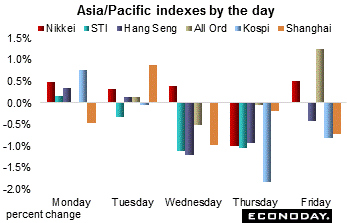 Most equity indexes retreated with only the All Ordinaries, Nikkei, Topix and Sensex advancing on the week. The All Ordinaries increased 0.8 percent, the Nikkei advanced 0.7 percent, the Topix gained 0.4 percent and the Sensex was 0.5 percent higher. Losses ranged from 2.7 percent (PSEi) and 2.3 percent (STI) to 0.6 percent (Taiex). At week’s end, Asian stocks were mixed in response to the dovish ECB statement and the BoJ's weaker view on the inflation outlook. Trade concerns persisted ahead of likely announcements of U.S. tariffs on Chinese goods. The euro extended declines against the dollar after the European Central Bank indicated plans to wind down its bond buying program and pledged to keep interest rates on hold for at least a year. Most equity indexes retreated with only the All Ordinaries, Nikkei, Topix and Sensex advancing on the week. The All Ordinaries increased 0.8 percent, the Nikkei advanced 0.7 percent, the Topix gained 0.4 percent and the Sensex was 0.5 percent higher. Losses ranged from 2.7 percent (PSEi) and 2.3 percent (STI) to 0.6 percent (Taiex). At week’s end, Asian stocks were mixed in response to the dovish ECB statement and the BoJ's weaker view on the inflation outlook. Trade concerns persisted ahead of likely announcements of U.S. tariffs on Chinese goods. The euro extended declines against the dollar after the European Central Bank indicated plans to wind down its bond buying program and pledged to keep interest rates on hold for at least a year.
Chinese shares hit a 20-month low on worries that rising trade tensions could add downward pressure to the country's economic growth. The Shanghai Composite dropped to its lowest level since September 2016 as the U.S. prepared to impose tariffs on Chinese goods. Subsequently on Friday, the tariffs were imposed after markets in Asia were closed for the week.
Hong Kong stocks suffered their worst weekly loss in nearly three months, as the prospect of further rate increases in the U.S. and an escalation in Sino-American trade frictions dragged on sentiment. The Hang Seng lost 2.1 percent on the week — the biggest loss since the week ended March 23. The Hong Kong dollar is pegged to its U.S. counterpart. When interest rates increase in the U.S., rates also increase in Hong Kong.
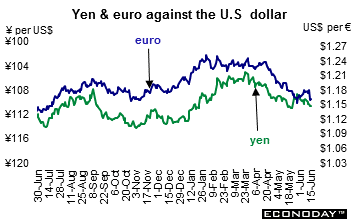 All of the U.S. dollar’s major counterparts — euro, pound, Swiss franc, yen and the Canadian and Australian dollars — tumbled on the week after the Federal Reserve increased U.S. interest rates and trade war troubles reverberated throughout the markets. In Europe, the European Central Bank put the emphasis on caution as it confirmed plans to stop buying bonds, a move described as a “Draghi tour de force” that has pummeled the euro and helped the dollar index touch a fresh high for 2018. The euro had the biggest fall against the dollar since June 2016. All of the U.S. dollar’s major counterparts — euro, pound, Swiss franc, yen and the Canadian and Australian dollars — tumbled on the week after the Federal Reserve increased U.S. interest rates and trade war troubles reverberated throughout the markets. In Europe, the European Central Bank put the emphasis on caution as it confirmed plans to stop buying bonds, a move described as a “Draghi tour de force” that has pummeled the euro and helped the dollar index touch a fresh high for 2018. The euro had the biggest fall against the dollar since June 2016.
|
|
2017 |
2018 |
% Change |
|
|
Dec 29 |
June 8 |
June 15 |
Week |
2018 |
| U.S. $ per currency |
|
|
|
|
|
|
| Australia |
A$ |
0.779 |
0.760 |
0.744 |
-2.0% |
-4.5% |
| New Zealand |
NZ$ |
0.709 |
0.704 |
0.694 |
-1.4% |
-2.0% |
| Canada |
C$ |
0.796 |
0.773 |
0.758 |
-2.0% |
-4.7% |
| Eurozone |
euro (€) |
1.194 |
1.177 |
1.161 |
-1.4% |
-2.8% |
| UK |
pound sterling (£) |
1.344 |
1.341 |
1.328 |
-1.0% |
-1.2% |
|
|
|
|
|
|
|
| Currency per U.S. $ |
|
|
|
|
|
|
| China |
yuan |
6.534 |
6.407 |
6.439 |
-0.5% |
1.5% |
| Hong Kong |
HK$* |
7.816 |
7.846 |
7.850 |
-0.1% |
-0.4% |
| India |
rupee |
64.081 |
67.513 |
68.018 |
-0.7% |
-5.8% |
| Japan |
yen |
112.850 |
109.470 |
110.610 |
-1.0% |
2.0% |
| Malaysia |
ringgit |
4.067 |
3.989 |
3.985 |
0.1% |
2.1% |
| Singapore |
Singapore $ |
1.338 |
1.335 |
1.352 |
-1.3% |
-1.0% |
| South Korea |
won |
1070.630 |
1075.880 |
1097.810 |
-2.0% |
-2.5% |
| Taiwan |
Taiwan $ |
29.775 |
29.811 |
30.011 |
-0.7% |
-0.8% |
| Thailand |
baht |
32.696 |
32.033 |
32.666 |
-1.9% |
0.1% |
| Switzerland |
Swiss franc |
0.979 |
0.9868 |
0.997 |
-1.0% |
-1.8% |
| *Pegged to U.S. dollar |
|
|
|
|
|
|
| Source: Bloomberg |
|
|
|
|
|
|
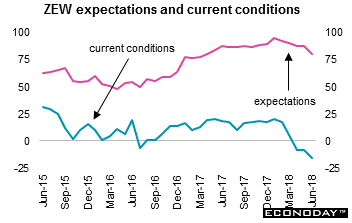 June ZEW survey current conditions measure weighed in at 80.6, a 6.8 point drop from its May reading and its fifth decline in as many months. It was also the weakest reading since April 2017. At the same time, expectations were off an even sharper 7.9 points at minus 16.1. This was their fourth decrease since January, the worst print since September 2012 and well short of their long-run average (23.3). The June findings suggest that analysts do not see the first quarter slowdown in economic activity as temporary. In particular, the ongoing downgrading of expectations — the index has slumped some 36.5 points since January — signals increasing concern about prospects for the second half of the year. ZEW attributed the soft results to worries about escalating international trade tensions, the risks to financial market stability inherent in the new Italian government and disappointing economic data at home. June ZEW survey current conditions measure weighed in at 80.6, a 6.8 point drop from its May reading and its fifth decline in as many months. It was also the weakest reading since April 2017. At the same time, expectations were off an even sharper 7.9 points at minus 16.1. This was their fourth decrease since January, the worst print since September 2012 and well short of their long-run average (23.3). The June findings suggest that analysts do not see the first quarter slowdown in economic activity as temporary. In particular, the ongoing downgrading of expectations — the index has slumped some 36.5 points since January — signals increasing concern about prospects for the second half of the year. ZEW attributed the soft results to worries about escalating international trade tensions, the risks to financial market stability inherent in the new Italian government and disappointing economic data at home.
 April industrial production contracted 0.8 percent on the month, its worst performance since last December and poor enough to reduce annual output growth from 2.9 percent to 1.8 percent, also a 4-month low. The key manufacturing sector was even weaker, registering a 1.4 percent monthly decline, its third drop in a row and the steepest since October 2012. The bulk of the damage was done by metals, where output fell 3.7 percent, alongside other manufacturing and repair (down 2.7 percent) and machinery and equipment (down 3.1 percent). However, declines were widespread with nine of the 13 reporting categories suffering setbacks. Total industrial production was boosted by a 6.9 percent spurt in the erratic mining and quarrying subsector that was only partially offset by decreases in water supply (1.8 percent) and electricity and gas (2.0 percent). April industrial production contracted 0.8 percent on the month, its worst performance since last December and poor enough to reduce annual output growth from 2.9 percent to 1.8 percent, also a 4-month low. The key manufacturing sector was even weaker, registering a 1.4 percent monthly decline, its third drop in a row and the steepest since October 2012. The bulk of the damage was done by metals, where output fell 3.7 percent, alongside other manufacturing and repair (down 2.7 percent) and machinery and equipment (down 3.1 percent). However, declines were widespread with nine of the 13 reporting categories suffering setbacks. Total industrial production was boosted by a 6.9 percent spurt in the erratic mining and quarrying subsector that was only partially offset by decreases in water supply (1.8 percent) and electricity and gas (2.0 percent).
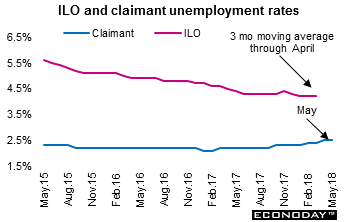 May claimant count number of people out of work declined 7,700. This followed a smaller revised, but still sizeable, 28,200 increase at the start of the quarter and was the first decline since January. The jobless rate was unchanged at 2.5 percent, although even this still matched its highest post since November 2014. The ILO statistics showed another 38,000 decrease in unemployment in the three months to April which left the rate steady at 4.2 percent and equaling its lowest outcome since the first quarter of 1975. Employment was up a solid 146,000 and there was also good news on vacancies which rose 2,000 and so reversed the previous period's fall. However, pay failed to respond. Hence, total weekly earnings grew at an annual rate of 2.5 percent in the three months to April, down a tick from the first quarter pace and the smallest rise since the three months to November 2017. Similarly, excluding bonuses, the rate dipped from 2.9 percent to 2.8 percent. As a result, real regular pay growth was unchanged at just 0.4 percent. May claimant count number of people out of work declined 7,700. This followed a smaller revised, but still sizeable, 28,200 increase at the start of the quarter and was the first decline since January. The jobless rate was unchanged at 2.5 percent, although even this still matched its highest post since November 2014. The ILO statistics showed another 38,000 decrease in unemployment in the three months to April which left the rate steady at 4.2 percent and equaling its lowest outcome since the first quarter of 1975. Employment was up a solid 146,000 and there was also good news on vacancies which rose 2,000 and so reversed the previous period's fall. However, pay failed to respond. Hence, total weekly earnings grew at an annual rate of 2.5 percent in the three months to April, down a tick from the first quarter pace and the smallest rise since the three months to November 2017. Similarly, excluding bonuses, the rate dipped from 2.9 percent to 2.8 percent. As a result, real regular pay growth was unchanged at just 0.4 percent.
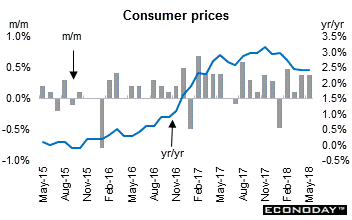 May consumer prices were up a monthly 0.4 percent with the annual inflation rate unchanged at 2.4 percent, matching its weakest reading since March 2017. The only major push to the change in the annual rate came from transport where a record monthly jump saw petrol prices climb to their highest level since October 2014. A partial offset was provided by recreational and cultural goods and services where charges were up 0.1 percent on the month compared with a 0.9 percent spike over the same period in 2017. Electricity (0.1 percent after 4.0 percent) also had a negative impact. As a result, the core CPI rose a smaller 0.3 percent on the month which saw its yearly rate flat at 2.1 percent. May consumer prices were up a monthly 0.4 percent with the annual inflation rate unchanged at 2.4 percent, matching its weakest reading since March 2017. The only major push to the change in the annual rate came from transport where a record monthly jump saw petrol prices climb to their highest level since October 2014. A partial offset was provided by recreational and cultural goods and services where charges were up 0.1 percent on the month compared with a 0.9 percent spike over the same period in 2017. Electricity (0.1 percent after 4.0 percent) also had a negative impact. As a result, the core CPI rose a smaller 0.3 percent on the month which saw its yearly rate flat at 2.1 percent.
 May retail sales were up 1.3 percent on the month after jumping an upwardly revised 1.8 percent in April. Annual growth of volumes was 3.9 percent, up from 1.4 percent last time and equaling the best performance since December 2016. Excluding auto fuel, purchases were up a monthly 1.3 percent and were 4.4 percent higher on the year. The monthly jump in overall sales was led by food where purchases gained 1.1 percent but non-food (0.7 percent) also enjoyed a decent period. The combination of seasonably warm weather and the Royal Wedding probably provided a broad-based lift. Within the non-food sector, non-store retailing (4.5 percent) was exceptionally buoyant but clothing and footwear (1.7 percent) and non-specialized stores (0.9 percent) similarly performed well. There were no declines among the main subsectors. Auto fuel advanced 1.0 percent. May retail sales were up 1.3 percent on the month after jumping an upwardly revised 1.8 percent in April. Annual growth of volumes was 3.9 percent, up from 1.4 percent last time and equaling the best performance since December 2016. Excluding auto fuel, purchases were up a monthly 1.3 percent and were 4.4 percent higher on the year. The monthly jump in overall sales was led by food where purchases gained 1.1 percent but non-food (0.7 percent) also enjoyed a decent period. The combination of seasonably warm weather and the Royal Wedding probably provided a broad-based lift. Within the non-food sector, non-store retailing (4.5 percent) was exceptionally buoyant but clothing and footwear (1.7 percent) and non-specialized stores (0.9 percent) similarly performed well. There were no declines among the main subsectors. Auto fuel advanced 1.0 percent.
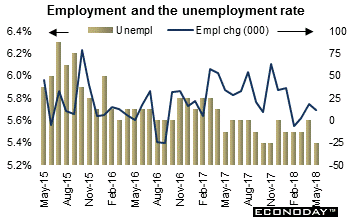 May employment increased 12,000 after a revised increase of 18,300 in April. The unemployment rate fell from 5.6 percent in April to 5.4 percent in May while the participation rate fell from 65.6 percent to 65.5 percent. The increase was entirely driven by part-time employment, up 32,600 on the month after falling by 9,700 previously. This was offset by a fall in full-time employment of 20,600 after an increase of 28,000 previously. The total numbers of hours worked fell 1.4 percent on the month in May after increasing 1.2 percent in April. Over the last 12 months, full-time employment has increased by 178,800 persons, while part-time employment has increased by 125,100 persons. May employment increased 12,000 after a revised increase of 18,300 in April. The unemployment rate fell from 5.6 percent in April to 5.4 percent in May while the participation rate fell from 65.6 percent to 65.5 percent. The increase was entirely driven by part-time employment, up 32,600 on the month after falling by 9,700 previously. This was offset by a fall in full-time employment of 20,600 after an increase of 28,000 previously. The total numbers of hours worked fell 1.4 percent on the month in May after increasing 1.2 percent in April. Over the last 12 months, full-time employment has increased by 178,800 persons, while part-time employment has increased by 125,100 persons.
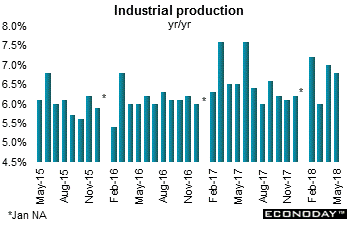 May industrial production was up 6.8 percent on the year after increasing 7.0 percent in April. On the month, output rose 0.58 percent after an increase of 0.61 percent in April. Weaker headline industrial production growth was driven by the manufacturing sector. Manufacturing production increased 6.6 percent on the year in May, down from 7.4 percent in April, with weaker growth in output of automobiles, textiles, chemicals, electric machinery and general equipment partly offset by stronger growth in output of steel products and communication equipment. Growth in the utilities sector, meanwhile, accelerated from 8.8 percent on the year in April to 12.2 percent in May, while mining output rebounded from a decline of 0.2 percent to an increase of 3.0 percent on the year. May industrial production was up 6.8 percent on the year after increasing 7.0 percent in April. On the month, output rose 0.58 percent after an increase of 0.61 percent in April. Weaker headline industrial production growth was driven by the manufacturing sector. Manufacturing production increased 6.6 percent on the year in May, down from 7.4 percent in April, with weaker growth in output of automobiles, textiles, chemicals, electric machinery and general equipment partly offset by stronger growth in output of steel products and communication equipment. Growth in the utilities sector, meanwhile, accelerated from 8.8 percent on the year in April to 12.2 percent in May, while mining output rebounded from a decline of 0.2 percent to an increase of 3.0 percent on the year.
Equities were mixed as investors tried to figure out what harm the imposition of tariffs would have on growth. Economic data were mixed globally. The Federal Reserve increased its fed funds interest rate by 25 basis points while the European Central Bank policy rates were unchanged. The ECB though did outline policy moves going forward. The Bank of Japan kept its policy unchanged.
The Bank of England and the Swiss National Bank meet on June 21. OPEC meets June 22 and 23 in Vienna where they will debate output policy. Saudi Arabia and Russia are saying that production should be increased “gradually” if deemed necessary. Flash manufacturing, services and composite PMIs will be released for a first look at June data. Otherwise it is a relatively quiet week.
| Central Bank activities |
|
| June 21 |
UK |
Bank of England Monetary Policy Announcement & Minutes |
|
Switzerland |
Swiss National Bank Quarterly Assessment |
| |
|
|
| The following indicators will be released this week... |
| Europe |
|
|
| June 18 |
Italy |
Merchandise Trade (April) |
| June 20 |
Germany |
Producer Price Index (May) |
| June 21 |
Eurozone |
EC Consumer Confidence (June flash) |
| June 22 |
Eurozone |
Manufacturing, Services & Composite PMI (June flash) |
|
Germany |
Manufacturing, Services & Composite PMI (June flash) |
|
France |
Manufacturing, Services & Composite PMI (June flash) |
|
|
Gross Domestic Product (Q1.2018) |
| |
|
|
| Asia Pacific |
|
|
| June 18 |
Japan |
Merchandise Trade (May) |
| June 22 |
Japan |
Consumer Price Index (May) |
|
|
Manufacturing PMI (June flash) |
| |
|
|
| Americas |
|
|
| June 22 |
Canada |
Consumer Price Index (May) |
|
|
Retail Sales (April) |
Anne D Picker is the author of International Economic Indicators and Central Banks.
|

